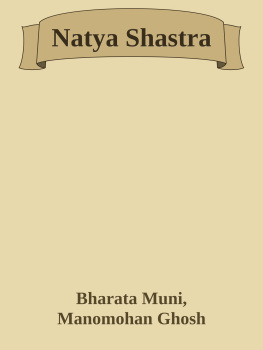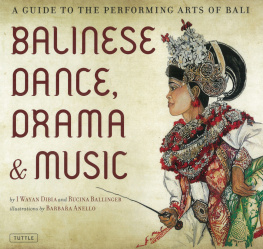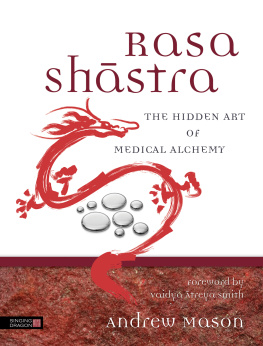THE NYASTRA
A Treatise on Hindu Dramaturgy and Histrionics
Ascribed to
Bharata-muni
Vol. I. (Chapters I-XXVII)
Vol. II. (Chapters XXVIII-XXXVI)
Completely translated for the first time from the original Sanskrit
with an Introduction and Various Notes
by
MANOMOHAN GHOSH M.A., PH.D. D. (Cal.)
CALCUTTA
The ROYAL ASIATIC SOCIETY OF BENGAL
1950
Dedicated to the memory of those great scholars of India and the West who by their indefatigable study and ingenious interpretation of her Religion, Philosophy, Literature and Arts, have demonstrated the high value of Indias culture to the World at large and have helped her towards a reawakening and, political liberation, and who by their discovery of the Universal aspect of this culture have made patent Indias spiritual kinship with the other ancient nations of the World and have paved the way for an ultimate triumph of Internationalism.
Index
Title Page
Dedication
Preface
Abbreviations and Symbols
Introduction, part 1
Part 1 - The Present Work Part 2 - The Ancient Indian Theory of Drama Part 3 - Literary Structure of the Drama Part 4 - The Ancient Indian Drama in Practice Part 5 - Literature on the Ancient Indian Drama Part 6 - The Nyastra: The Text and its Commentators Part 7 - Data of Indias Cultural History in the Nyastra Part 8 - The Date of the NyastraIntroduction, Part 2
Part 1 - The Present Work Part 2 - The Ancient Indian Theory and Practice of Music Part 3 - Literature on Ancient Indian Music Part 4 - More About the Ancient Indian Theory and Practice of Drama Part 5 - More Data of Indias Cultural History in the NyastraChapter I - Origin of Drama (nya)
Chapter II - Description of the Playhouse (nyamaapa)
Chapter III - Pj to the Gods of the Stage (ragapj)
Chapter IV - Description of the Class Dance (tava)
Chapter V - Preliminaries of a Play (prvaraga)
Chapter VI - Sentiments (rasa)
Chapter VII - Emotional and other States (bhva)
Chapter VIII - Gestures of Minor Limbs (upga)
Chapter IX - Gestures of Major Limbs (aga)
Chapter X - Gestures of other Limbs
Chapter XI - Cr movements
Chapter XII - Maala movements
Chapter XIII - Different Gaits (gati)
Chapter XIV - Zones (kaky) and Local Usages (pravtti)
Chapter XV - Verbal representation (vcika) and Prosody (chandastra)
Chapter XVI - Metrical Patterns (chandas)
Chapter XVII - Diction of a Play (lakaa)
Chapter XVIII - Rules on the use of Languages (bh)
Chapter XIX - Modes of Address (nman) and Intonation (kku)
Chapter XX - Ten Kinds of Play (daarpa)
Chapter XXI - Limbs of Segments (sandhi)
Chapter XXII - Styles (vtti)
Chapter XXIII - Costumes and Make-up (nepathya)
Chapter XXIV - Harmonious Representation (smnybhinaya)
Chapter XXV - Dealings with Courtezans (vey)
Chapter XXVI - Varied Representation (citrbhinaya)
Chapter XXVII - Success in Dramatic Production (siddhi)
Chapter XXVIII - On the Instrumental Music (todya)
Chapter XXIX - On Stringed Instruments (tata)
Chapter XXX - On Hollow Instruments (suira)
Chapter XXXI - On the Time-measure (tla)
Chapter XXXII - The Dhruv Songs
Chapter XXXIII - On Covered Instruments (avanaddha)
Chapter XXXIV - Types of Characters (prakti)
Chapter XXXV - Distribution of Roles (bhmik)
Chapter XXXVI - Descent of Drama on the Earth
Preface
The preparation of an annotated English translation of the Ntyastra entrusted to me as early as 1944, by the Royal Asiatic Society, has been delayed for various reasons which need not be recounted here in detail. But mention must be made of one important factor of this delay, viz., the inherent difficulty of this very old text which is not yet available in a complete critical edition. From my first serious acquaintance with it in 1925 in connection with the editing of the Abhinayadarpana (Calcutta, 1934) this work has always engaged my attention in the intervals of other duties. But it was only a few years ago, that I came to believe that the entire work could be translated into English. It was, however, only after making some actual progress in translation that I realised the difficulty of the task and understood to some extent at least why no complete translation of this very important text had so far not been made.
However, I considered it a duty to make strenuous efforts and proceeded patiently with the work and finished at last translating the major portion of the Nyastra. I am now genuinely happy to place it before the scholarly public, not because it could be done in an ideal fashion, but because it could be finished at all.
In handling a difficult old text like this it it natural that one has to offer conclusions and interpretations, here and there, which due to the absence of better materials cannot be placed on surer grounds. But whatever tentative assertions I have made, have been made after the most careful consideration with the expectation that they may prove helpful to others working in this field, and it may be hoped that their number has not been too many, and in a few cases where I myself had any doubt about the interpretation offered, the same has been expressly mentioned in the footnote.
The chapters on music covering a little more than one fourth of the Nyastra still remain to be done. These when completed will be published in the second volume. As the work on it, is progressing very slowly and it cannot be said definitely when it will be finished, it was thought advisable to publish the portion of the translation already prepared. Though the musical terms occurring in the present volume remain undefined, the absence of chapters on music where they have been discussed, will not, it is hoped, seriously interfere with the understanding of the dramaturgy and histrionics treated here.
For information regarding the plan and scope of the present work, the reader is referred to the Introduction, section I.
For the purpose of this volume, works of various scholars have been helpful to the translator and they have been mentioned in proper places. But among them all, th American Sanskritist Dr. G. C. O. Has deserves to be specially mentioned; for his plan of the translation of the Daarpa, has been adopted in a slightly modified manner in the present work.
I am indebted to Dr. S. K. De, due to whose kindness I could utilise the unpublished portion of the Abinavabhrat. It is also a great pleasure to acknowledge the uniform courtesy of different officers of the Society from 1947-1950, especially Dr. K.N. Bagchi, and Dr. Niharanjan Ray, the General Secretaries and Mr. S. K. Saraswati, the Librarian and Mr. Rakhahari Chatterji. the Superintendent of the office, whose patience I had to tax on different occasions in course of the publication.
I am grateful to my father-in-law Sri Kali Charan Mitra who read the original draft of the first fourteen chapters of the present work and made suggestions regarding the language, and to my esteemed friend Dr. S. N. Ray, M.A., Ph.D. (London) formerly Head of the Department of English in the University of Dacca, for reading the proof of the first twelve formes and also for going through in Mss. the Introduction and for making welcome suggestions.
I wish to mention here very gratefully the debt I owe to Dr. Kalidas Nag in connexion with the preparation and the publication of this work. But for his suggestion to undertake this work it might not have reached at all the stage of publication.
Last but not the least it becomes my most cheerful duty to express my gratitude to Prof. Suniti Kumar Chatterji, who has also helped me otherwise in connexion with this work. This help and his constant encouragement have rendered this work less arduous than it might otherwise have been.
Next page








